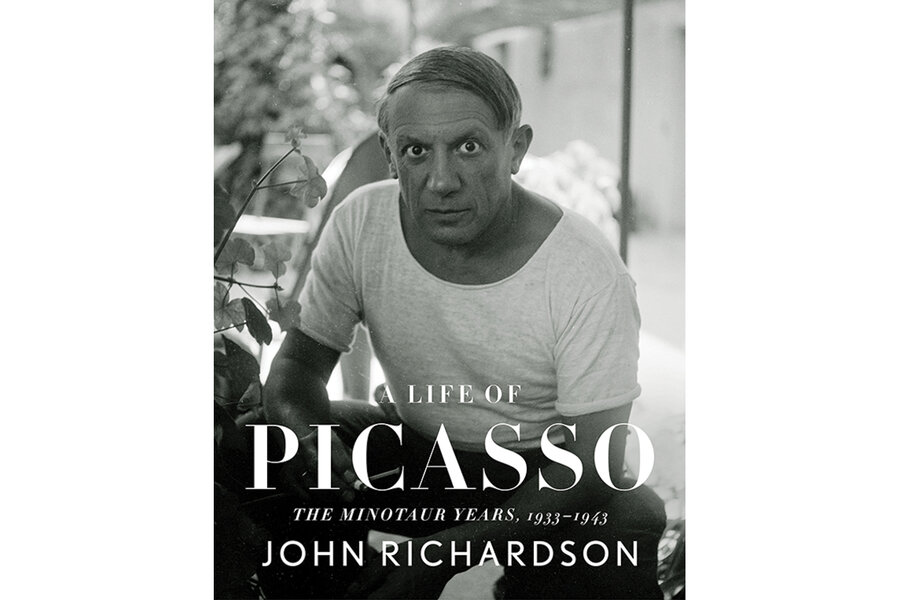Picasso painted with passion, intensity, and utter disregard
Loading...
Pablo Picasso may well have been the greatest artist of the 20th century. Creative and ferociously productive over a long career, he reshaped the way artists see the world and their role in it. Every adjective associated with artistic greatness – brilliant, illustrious, trailblazing – has been applied to him. Major exhibitions of his works are almost always blockbusters.
There are shelves of biographies that explain what made Picasso tick. But no one has written about him with more clarity and insight than the legendary British art historian John Richardson. As a friend of the artist, Richardson had access to Picasso over many years and he has used this personal connection to provide a complete, and richer, but still honest, portrait of the painter.
“A Life of Picasso: The Minotaur Years, 1933-1943” is the fourth in the Picasso biography series that Richardson, who died in 2019, started writing in the 1980s. The earlier volumes chart the artist’s life and career from his youth in Barcelona, Spain, through his early years in Paris. The latest installment was released posthumously in November, and its subtitle refers to the mythical half-man and half-bull who often acts as a stand-in for the artist in his pictures. The book is every bit as rewarding and impressive as the three that preceded it.
World’s best-known anti-war painting
We begin with Picasso, now middle-aged, at the height of his artistic powers. The book covers in detail the extraordinary sculptural works created at Boisgeloup, the Norman château he purchased in 1930; his flirtation with the surrealists; his experimentation with poetry and decision to abandon painting for a year to give him time to write; the series of paintings known as “Weeping Women”; his summers on the French Riviera; the painting of “Night Fishing at Antibes” as well as “Guernica”; and Picasso’s decision to stay in Paris during World War II.
The outbreak of the Spanish Civil War was traumatic for Picasso, who was still a citizen of Spain. He was squarely on the side of the Republicans – who were fighting against the Nationalists led by Gen. Francisco Franco – and provided significant financial support to them.
He was asked to prepare a painting for the Spanish Pavilion at the 1937 world’s fair in Paris, and his initial concept was for a painting of an artist in his studio with a model. But then, on April 26, 1937, the Germans bombed Guernica and the direction of the project changed completely. Picasso quickly completed a massive painting that graphically details the violence of the attack and the chaos and suffering that resulted. Now regarded as one of the most important paintings of the 20th century, the work was coolly received in Paris.
Shadow side
Picasso had a dark side: He was a lifelong misogynist, and his abusive treatment of those closest to him is legendary. In this book, we watch the psychological collapse of his first wife, Olga; the institutionalization of the son he tried to ignore; and the toxic and destructive relationship with Dora Maar, his mistress when he painted “Guernica.” Maar was the subject of the “Weeping Woman” paintings, and Richardson notes that Picasso’s treatment of her image “has disturbing echoes of cruelty, confinement, and torture.” Always in the background is his first mistress, Marie-Thérèse Walter, and their daughter, Maya.
It’s not just women, of course. Richardson documents the casual cruelty that Picasso meted out to men, women, family members, and close friends. He was an equal opportunity tormentor.
It used to be that such behavior in great artists was explained away by invoking the term “artistic temperament.” Those days have long passed. The biographer does not speculate as to why Picasso was capable of great cruelty – such an assessment would require a deep dive into psychology, which is outside the expertise of an art historian. Rather, Richardson’s accomplishment is to let us see Picasso in full – as an artist of enormous consequence and as a terribly flawed human being.
Impressed by Van Gogh
Richardson provides personal and artistic details that enrich the story. We learn, for example, that Picasso, who loved fine cars, never drove and ridiculed artists like Georges Braque (who drove a Rolls-Royce) and André Derain (who favored Bugattis) who did. His younger sister, Conchita, whose death in 1895 haunted Picasso, appears in “Guernica” as an adult woman holding a lamp. It’s well known that Picasso admired Vincent van Gogh, but Richardson augments this information by noting that Picasso carried in his wallet until the day he died an original newspaper account of Van Gogh’s attempt to cut off his ear. And it’s entertaining to imagine André Breton, who was dubbed the Pope of Surrealism for his arrogance and imperiousness, trying to ingratiate himself into Picasso’s life so he could lure the artist into the surrealist movement. He failed.
Richardson’s death means that the multivolume “A Life of Picasso” series ends in the early 1940s. Picasso lived for another 30 years. How sad that the biographer was unable to complete the project. But how fortunate that he completed four volumes.
Many more biographies will be written about Picasso. But it is difficult to imagine that any of them will surpass the achievement of Richardson’s “Life of Picasso.” For readers looking to fully understand Picasso as an artist and as a person, Richardson’s books are the indispensable starting point. A great artist now enjoys a biography worthy of at least part of his life and work.








